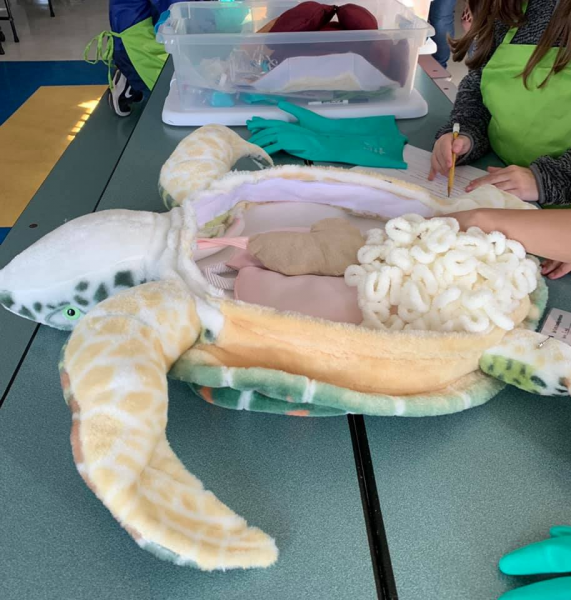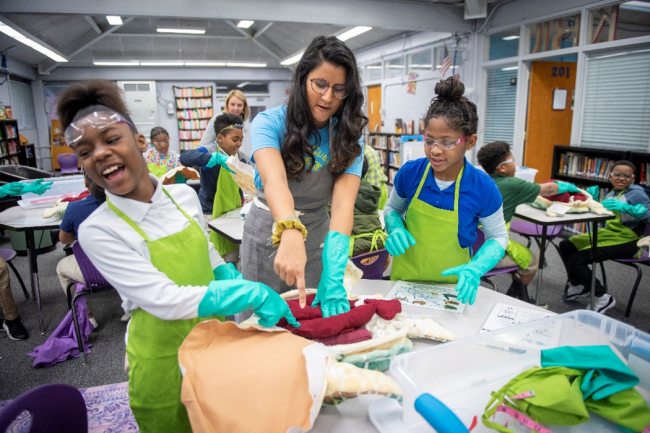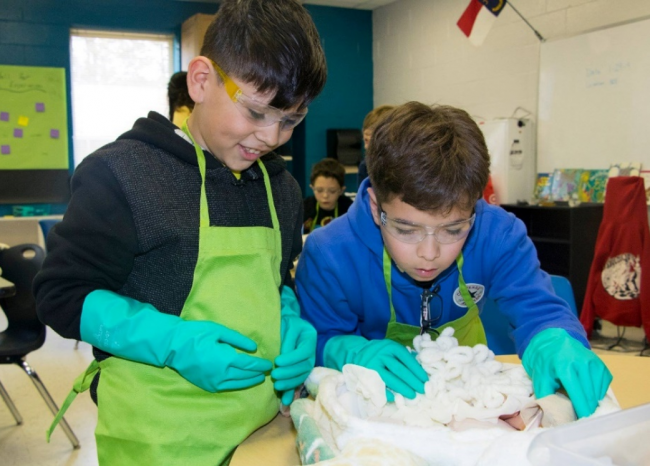
Guest Blog By: Sue Kezios and Laura Sirak-Schaeffer, University of North Carolina Wilmington MarineQuest
When we decided to convert a stuffed toy sea turtle into a model for simulating a necropsy (or animal dissection), we never imagined how impactful the experience would be for kids. With funding from a NOAA Marine Debris Program Prevention Grant, the University of North Carolina Wilmington (UNCW) MarineQuest created Turtle Trash Collectors (2TC) to help children understand the marine debris issue and to provide ways for them to address the problem. The necropsy simulation is the heart of the project, and it goes something like this:
First, students don their protective aprons, pull on the elbow length rubber gloves, and adjust their safety goggles. Then they consult the tag attached to the flipper of a stuffed turtle and note the location and date it was found. Using a measuring tape, they document its size and estimate its age. Any external injuries, scars or entanglements are noted on a data sheet. Next, they carefully insert a 3D printed kid-safe scalpel between the upper and lower shell to remove the plastron, or bottom shell, exposing the large red pectoral muscles. Then you hear it - someone is gagging. Another student is screwing up his face as if the smell of decay is overwhelming him. Still others are gamely plowing ahead and carefully moving the muscles to the side to reveal the digestive system. One girl discovers what feels like a bottle cap in the turtle’s throat. Another student shouts, “I think I can see something!” Classmates hurry over and watch in amazement as she pulls a plastic bag from the turtle’s stomach. They all agree, marine debris is the culprit and they are both angry and sad. At this moment, the simulation truly becomes real.

The 2TC project leverages young people’s fondness for sea turtles to cultivate concern for the impacts of marine debris on these species. By participating in our simulated necropsies, the problem of marine debris becomes real to the kids. All of the debris removed during the simulation represents items that the students themselves might generate. Snack wrappers, juice pouches, straws, and even birthday party balloons, connect the debris to the children’s own choices and actions. We help students identify reusable alternatives that they can choose and help to make a difference. Then, we brainstorm how the debris items got into the areas of the ocean where sea turtles spend time, and identify locations where clean ups might be most helpful right in their community. The 2TC staff plan these cleanups and invite the students to participate. We also invite them to join the 2TC digital badging program, a reward system that helps participants develop good habits, such as using fewer single-use items and cleaning up marine debris. Their willingness to participate in this program is an indicator of an internal behavioral change in which they take action – cleaning up.
From simulation, to realization, internalization, and action - this is the power of 2TC. And to think, it all started with a stuffed toy.



What a tremendously impactful experience for these young scientists! Well done! I would LOVE to have a set of these turtles! I teach in Truro (Cape Cod), MA. Sea turtles and marine debris are huge topics for all of my K-6 science classes. They learn how to rescue cold stunned Kemp’s Ridley and loggerheads with the help of our partners at Wellfleet Audubon and participate in beach clean ups. Every year our second graders get hands on experiences identifying sea turtle species with one of NOAA NEFSC’s turtle biologists, Heather Haas during our NOAA Ocean Day. This year we participated in the NOAA Zero Waste Challenge—and our school reduced our single use plastic by 70% in one week. To help bring the idea gone to kids, our simulated experience took the form of dissecting a “Fauxbatross” bolus that I created from newspaper pulp and marine debris collected from our beaches. When kids can personally identify with this problem they are definitely willing to personally work to change it as well as educate others.
Did I mention I would love a set of these? Are there directions for making them? A curriculum you are willing to share? I’ll trade you for my Fauxbatross materials. ;-)